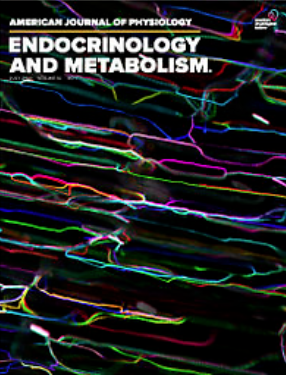Hyperglycemia impairs EAAT2 glutamate transporter trafficking and glutamate clearance in islets of Langerhans: implications for type 2 diabetes pathogenesis
IF 4.2
2区 医学
Q1 ENDOCRINOLOGY & METABOLISM
American journal of physiology. Endocrinology and metabolism
Pub Date : 2024-05-01
DOI:10.1152/ajpendo.00069.2024
引用次数: 0
Abstract
Pancreatic endocrine cells employ a sophisticated system of paracrine and autocrine signals to synchronize their activities, including glutamate which controls hormone release and β-cell viability by acting on glutamate receptors expressed by endocrine cells. We here investigate whether alteration of the Excitatory Amino Acid Transporter 2 (EAAT2), the major glutamate clearance system in the islet, may occur in type 2 diabetes mellitus (T2DM) and contribute to β-cell dysfunction. Increased EAAT2 intracellular localization was evident in islets of Langerhans from T2DM subjects as compared with healthy control subjects, despite similar expression levels. Chronic treatment of islets from healthy donors with high glucose concentrations led to the transporter internalization in vesicular compartments and reduced [H3]-D-glutamate uptake (65±5% inhibition), phenocopying the findings in T2DM pancreatic sections. The transporter relocalization was associated to decreased Akt phosphorylation protein levels, suggesting an involvement of the PI3K/Akt pathway in the process. In line with this, PI3K inhibition by 100 µM LY294002 treatment in human and clonal β-cells, caused the transporter relocalization in intracellular compartments and significantly reduced the glutamate uptake compared to control conditions, suggesting that hyperglycemia changes the trafficking of the transporter to the plasma membrane. Upregulation of the glutamate transporter upon treatment with the antibiotic ceftriaxone rescued hyperglycemia-induced β-cells dysfunction and death. Our data underscore the significance of EAAT2 in regulating islet physiology and provide a rationale for potential therapeutic targeting of this transporter to preserve β-cell survival and function in diabetes.高血糖会损害朗格汉斯胰岛中 EAAT2 谷氨酸转运体的贩运和谷氨酸的清除:对 2 型糖尿病发病机制的影响
胰腺内分泌细胞采用一套复杂的旁分泌和自分泌信号系统来同步其活动,其中包括谷氨酸,它通过作用于内分泌细胞表达的谷氨酸受体来控制激素的释放和β细胞的活力。兴奋性氨基酸转运体 2(EAAT2)是胰岛中主要的谷氨酸清除系统,我们在此研究它是否会在 2 型糖尿病(T2DM)中发生改变并导致β细胞功能障碍。尽管表达水平相似,但与健康对照组相比,T2DM 患者的朗格汉斯胰岛中 EAAT2 细胞内定位明显增加。用高浓度葡萄糖对健康供体的胰岛进行慢性处理会导致转运体在囊泡内化,并减少[H3]-D-谷氨酸的摄取(抑制率为 65±5%),这与 T2DM 胰腺切片中的发现相同。转运体的重新定位与 Akt 磷酸化蛋白水平的降低有关,表明 PI3K/Akt 途径参与了这一过程。与此相一致,在人和克隆β细胞中用100 µM LY294002抑制PI3K,会导致转运体在细胞内重新定位,与对照组相比,谷氨酸摄取量显著减少,这表明高血糖会改变转运体向质膜的迁移。用抗生素头孢曲松处理谷氨酸转运体后,谷氨酸转运体的上调可缓解高血糖引起的β细胞功能障碍和死亡。我们的数据强调了 EAAT2 在调节胰岛生理机能方面的重要作用,并为针对该转运体的潜在治疗提供了理论依据,以保护糖尿病患者 β 细胞的存活和功能。
本文章由计算机程序翻译,如有差异,请以英文原文为准。
求助全文
约1分钟内获得全文
求助全文
来源期刊
CiteScore
9.80
自引率
0.00%
发文量
98
审稿时长
1 months
期刊介绍:
The American Journal of Physiology-Endocrinology and Metabolism publishes original, mechanistic studies on the physiology of endocrine and metabolic systems. Physiological, cellular, and molecular studies in whole animals or humans will be considered. Specific themes include, but are not limited to, mechanisms of hormone and growth factor action; hormonal and nutritional regulation of metabolism, inflammation, microbiome and energy balance; integrative organ cross talk; paracrine and autocrine control of endocrine cells; function and activation of hormone receptors; endocrine or metabolic control of channels, transporters, and membrane function; temporal analysis of hormone secretion and metabolism; and mathematical/kinetic modeling of metabolism. Novel molecular, immunological, or biophysical studies of hormone action are also welcome.

 求助内容:
求助内容: 应助结果提醒方式:
应助结果提醒方式:


